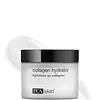What's inside
What's inside
 Key Ingredients
Key Ingredients

 Benefits
Benefits

 Concerns
Concerns

No concerns
 Ingredients Side-by-side
Ingredients Side-by-side

Water
Skin ConditioningC12-15 Alkyl Benzoate
AntimicrobialGlycerin
HumectantGlyceryl Stearate
EmollientCetearyl Alcohol
EmollientIsopropyl Palmitate
EmollientButyrospermum Parkii Butter
Skin ConditioningCyclopentasiloxane
EmollientDimethicone
EmollientCetyl Alcohol
EmollientPolysorbate 60
EmulsifyingTetrahexyldecyl Ascorbate
AntioxidantAllantoin
Skin ConditioningAloe Barbadensis Leaf Extract
EmollientChamomilla Recutita Flower Extract
MaskingCucumis Sativus Fruit Extract
EmollientEthylhexylglycerin
Skin ConditioningGlycol Distearate
EmollientHelianthus Annuus Seed Oil
EmollientHydrolyzed Wheat Protein
Skin ConditioningOlea Europaea Fruit Oil
MaskingPhenoxyethanol
PreservativePotassium Cetyl Phosphate
EmulsifyingPrunus Amygdalus Dulcis Oil
Skin ConditioningSodium Hyaluronate
HumectantSodium PCA
HumectantTocopherol
AntioxidantXanthan Gum
EmulsifyingCarbomer
Emulsion StabilisingSodium Hydroxide
BufferingTetrasodium EDTA
Water, C12-15 Alkyl Benzoate, Glycerin, Glyceryl Stearate, Cetearyl Alcohol, Isopropyl Palmitate, Butyrospermum Parkii Butter, Cyclopentasiloxane, Dimethicone, Cetyl Alcohol, Polysorbate 60, Tetrahexyldecyl Ascorbate, Allantoin, Aloe Barbadensis Leaf Extract, Chamomilla Recutita Flower Extract, Cucumis Sativus Fruit Extract, Ethylhexylglycerin, Glycol Distearate, Helianthus Annuus Seed Oil, Hydrolyzed Wheat Protein, Olea Europaea Fruit Oil, Phenoxyethanol, Potassium Cetyl Phosphate, Prunus Amygdalus Dulcis Oil, Sodium Hyaluronate, Sodium PCA, Tocopherol, Xanthan Gum, Carbomer, Sodium Hydroxide, Tetrasodium EDTA
Water
Skin ConditioningHydrogenated Polyisobutene
EmollientGlycerin
Humectant1,2-Hexanediol
Skin ConditioningHydroxyethyl Acrylate/Sodium Acryloyldimethyl Taurate Copolymer
Emulsion StabilisingGlyceryl Stearate
EmollientPEG-100 Stearate
Squalane
EmollientPalmaria Palmata Extract
Skin ProtectingHydrolyzed Hyaluronic Acid
HumectantSodium Hyaluronate
HumectantTocopheryl Acetate
AntioxidantPhenoxyethanol
PreservativePolysorbate 60
EmulsifyingSorbitan Isostearate
EmulsifyingCetyl Alcohol
EmollientTrisodium Ethylenediamine Disuccinate
Water, Hydrogenated Polyisobutene, Glycerin, 1,2-Hexanediol, Hydroxyethyl Acrylate/Sodium Acryloyldimethyl Taurate Copolymer, Glyceryl Stearate, PEG-100 Stearate, Squalane, Palmaria Palmata Extract, Hydrolyzed Hyaluronic Acid, Sodium Hyaluronate, Tocopheryl Acetate, Phenoxyethanol, Polysorbate 60, Sorbitan Isostearate, Cetyl Alcohol, Trisodium Ethylenediamine Disuccinate
 Reviews
Reviews

Ingredients Explained
These ingredients are found in both products.
Ingredients higher up in an ingredient list are typically present in a larger amount.
Cetyl Alcohol is a fatty alcohol. Fatty Alcohols are most often used as an emollient or to thicken a product.
Its main roles are:
Though it has "alcohol" in the name, it is not related to denatured alcohol or ethyl alcohol.
The FDA allows products labeled "alcohol-free" to have fatty alcohols.
Learn more about Cetyl AlcoholGlycerin is already naturally found in your skin. It helps moisturize and protect your skin.
A study from 2016 found glycerin to be more effective as a humectant than AHAs and hyaluronic acid.
As a humectant, it helps the skin stay hydrated by pulling moisture to your skin. The low molecular weight of glycerin allows it to pull moisture into the deeper layers of your skin.
Hydrated skin improves your skin barrier; Your skin barrier helps protect against irritants and bacteria.
Glycerin has also been found to have antimicrobial and antiviral properties. Due to these properties, glycerin is often used in wound and burn treatments.
In cosmetics, glycerin is usually derived from plants such as soybean or palm. However, it can also be sourced from animals, such as tallow or animal fat.
This ingredient is organic, colorless, odorless, and non-toxic.
Glycerin is the name for this ingredient in American English. British English uses Glycerol/Glycerine.
Learn more about GlycerinGlyceryl Stearate is a mix of glycerin and stearic acid.
It is used to stabilize the mixing of water and oil ingredients. By preventing these ingredients from separating, it can help elongate shelf life. It can also help thicken the product's texture.
As an emollient, it helps soften skin and supports barrier-replenishing ingredients.
In cosmetics, Glyceryl Stearate is often made from vegetable oils or synthetically produced.
This ingredient may not be fungal-acne safe
Fun fact: The human body also creates Glyceryl Stearate naturally.
Learn more about Glyceryl StearatePhenoxyethanol is a preservative that has germicide, antimicrobial, and aromatic properties. Studies show that phenoxyethanol can prevent microbial growth. By itself, it has a scent that is similar to that of a rose.
It's often used in formulations along with Caprylyl Glycol to preserve the shelf life of products.
Polysorbate 60 is used to help stabilize products. It is a surfactant and emulsifier. These properties help keep ingredients together in a product. Surfactants help reduce surface tension between ingredients with different states, such as liquids and solids. Emulsifiers help prevent oils and waters from separating.
Polysorbate 60 is sorbitol-based and created from the ethoxylation of sorbitan. Ethoxylation is a chemical reaction used to add ethylene oxide. Sorbitan is a the dehydrated version of sorbitol, a sugar found in fruits.
In this case, the 60 comes from reacting 60 units of ethylene oxide with sorbitan.
Polysorbates are commonly used in medicine and foods.
Learn more about Polysorbate 60Sodium Hyaluronate is hyaluronic acid's salt form. It is commonly derived from the sodium salt of hyaluronic acid.
Like hyaluronic acid, it is great at holding water and acts as a humectant. This makes it a great skin hydrating ingredient.
Sodium Hyaluronate is naturally occurring in our bodies and is mostly found in eye fluid and joints.
These are some other common types of Hyaluronic Acid:
Learn more about Sodium HyaluronateWater. It's the most common cosmetic ingredient of all. You'll usually see it at the top of ingredient lists, meaning that it makes up the largest part of the product.
So why is it so popular? Water most often acts as a solvent - this means that it helps dissolve other ingredients into the formulation.
You'll also recognize water as that liquid we all need to stay alive. If you see this, drink a glass of water. Stay hydrated!
Learn more about Water